.
Administrative Region : North Aegean
Regional unit : Lesvos
Lesbos (Greek: Λέσβος, transliterated from Modern Greek as Lesvos, sometimes also referred to as Mytilini after its major city Mytilene) is a Greek island located in the northeastern Aegean Sea. It has an area of 1,632 km2 (630 sq mi) with 320 kilometres (almost 200 miles) of coastline, making it the third largest Greek island. It is separated from Turkey by the narrow Mytilini Strait.
Lesbos is a separate regional unit of the North Aegean region, and the only municipality of the regional unit. Its population is approximately 90,000, a third of which lives in its capital, Mytilene, in the southeastern part of the island. The remaining population is distributed in small towns and villages. The largest are Kalloni, the Gera Villages, Plomari, Agiassos, Eresos, and Molyvos (the ancient Mythymna).
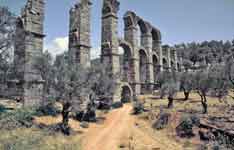
Lesbos , Moria Aqueduct 2nd c. AD
Mytilene was founded in the 11th century BC by the family Penthilidae, who arrived from Thessaly, and ruled the city-state until a popular revolt (590–580 BC) led by Pittacus of Mytilene ended their rule. In early Middle Ages, it was under Byzantine and Genovese rule. Lesbos was conquered by the Ottoman Empire in 1462, who ruled the island until the First Balkan War in 1912, when it became part of the Kingdom of Greece.
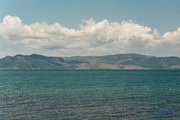
A view of Kallonis Bay [Source]
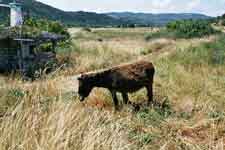
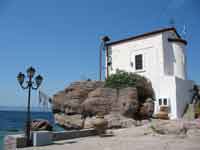
Geography
Satellite photo of Lesbos (1995)
Lesbos lies in the far east of the Aegean sea, facing the Turkish coast (Gulf of Edremit) from the north and east; at the narrowest point, the strait is about 5.5 km (3.4 mi) wide. Its shape is roughly triangular, but it is deeply intruded by the gulfs of Kalloni, with an entry on the southern coast, and of Gera, in the southeast.[1]
The island is forested and mountainous with two large peaks, Mt. Lepetymnos at 968 m (3,176 ft) and Mt. Olympus at 967 m (3,173 ft), dominating its northern and central sections.[2] The island’s volcanic origin is manifested in several hot springs and the two gulfs.
Lesbos is verdant, aptly named Emerald Island, with a greater variety of flora than expected for the island's size. Eleven million olive trees cover 40% of the island together with other fruit trees. Forests of mediterranean pines, chestnut trees and some oaks occupy 20%, and the remainder is scrub, grassland or urban. In the western part of the island is the world’s second largest petrified forest of Sequoia.
Climate
The island has a mild Mediterranean climate. The mean annual temperature is 18 °C (64 °F), and the mean annual rainfall is 750 mm (30 in). Its exceptional sunshine makes it one of the sunniest islands in the Aegean Sea. Snow and very low temperatures are rare.
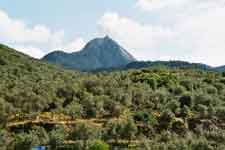
Olympos peak rises 968 meters over Lesbos
History
View of the Roman aqueduct.
In the days of Sappho by John William Godward (1904).
According to Classical Greek mythology, Lesbos was the patron god of the island. Macar was reputedly the first king whose many "daughters" bequeathed their names to some of the present larger towns. In Classical myth his "sister", Canace, was killed to have him made king. The place names with female origins are likely to be much earlier settlements named after local goddesses, who were replaced by gods. Homer refers to the island as "Macaros edos", the seat of Macar. Hittite records from the Late Bronze Age name the island Lazpa and must have considered its population significant enough to allow the Hittites to "borrow their gods" (presumably idols) to cure their king when the local gods were not forthcoming. It is believed that emigrants from mainland Greece, mainly from Thessaly, entered the island in the Late Bronze Age and bequeathed it with the Aeolic dialect of the Greek language, whose written form survives in the poems of Sappho, amongst others.
The abundant gray pottery ware found on the island and the worship of Cybele, the great mother-goddess of Anatolia, suggest the cultural continuity of the population from Neolithic times. When the Persian king Cyrus defeated Croesus (546 BC) the Ionic Greek cities of Anatolia and the adjacent islands became Persian subjects and remained such until the Persians were defeated by the Greeks at the Battle of Salamis (480 BC). The island was governed by an oligarchy in archaic times, followed by quasi-democracy in classical times. For a short period it was a member of the Athenian confederacy, its apostasy from which is described in a stirring chapter of Thucydides' history of the Peloponnesian War. In Hellenistic times, the island belonged to various Successor kingdoms until 79 BC when it passed into Roman hands.
Map of Lesbos by Giacomo Franco (1597).
The entrance of Ipsalou Monastery.
During the Middle Ages it belonged to the Byzantine Empire. In 803, the Byzantine Empress Irene was exiled to Lesbos, forced to spin wool to support herself, and died there.
After the Fourth Crusade (1202–1204) the island passed to the Latin Empire, but was reconquered by the Byzantines in 1247. In 1355, it was granted to the Genoese Gattilusi family for economic and political reasons. The island was conquered by the Ottoman Turks in 1462. It remained under Turkish rule, named Midilli in Turkish, until 1912 when it was taken by Greek forces during the First Balkan War. The cities of Mytilene and Mithymna have been bishoprics since the 5th century.
The oldest artifacts found on the island date to the Paleolithic period.[3] Important archaeological sites on the island are the Neolithic cave of Kagiani, probably a refuge for shepherds, the Neolithic settlement of Chalakies, and the extensive habitation of Thermi (3000–1000 BC). The largest habitation is found in Lisvori (2800–1900 BC) part of which is submerged in shallow coastal waters. There are also several archaic, classical Greek and Roman remains. Vitruvius called the ancient city of Mytilene "magnificent and of good taste". Remnants of its medieval history are three impressive castles.
Lesbos is the birthplace of several famous persons. In archaic times, Arion developed the type of poem called dithyramb, the progenitor of tragedy, and Terpander invented the seven note musical scale for the lyre. Two of the nine lyric poets in the Ancient Greek canon, Alcaeus and Sappho, were from Lesbos. Phanias wrote history. The seminal artistic creativity of those times brings to mind the myth of Orpheus to whom Apollo gave a lyre and the Muses taught to play and sing. When Orpheus incurred the wrath of the god Dionysus he was dismembered by the Maenads and of his body parts his head and his lyre found their way to Lesbos where they have "remained" ever since. Pittacus was one of the Seven Sages of Greece. In classical times Hellanicus advanced historiography, Theophrastus, the father of botany, succeeded Aristotle as the head of the Lyceum. Aristotle and Epicurus lived there for some time, and it is there that Aristotle began systematic zoological investigations. In later times lived Theophanes, the historian of Pompey's campaigns, Longus wrote the famous novel Daphnis and Chloe, and much later the historian Doukas wrote the history of the early Ottoman Turks. In modern times the poet Odysseus Elytis, descendant of an old family of Lesbos received the Nobel Prize.
Sights
Plomari
Mithymna
Skala of Eresos-Antissa
Ouzo Plomari of Lesbos
Twelve historic churches on the island were listed together on the 2008 World Monuments Fund's Watch List of the 100 Most Endangered Sites in the world. Exposure to the elements, outmoded conservation methods, and increased tourism are all threats to the structures. It is hoped[who?] that increased attention to their declining states will aid in their preservation.
Petrified forest
Main article: Petrified forest of Lesbos
Lesbos contains one of the few known petrified forests and has been declared a Protected Natural Monument, included also in the European Geopark Network. Fossilised plants have been found in many localities on the western part of the island. The fossilised forest was formed during the Late Oligocene to Lower–Middle Miocene, by the intense volcanic activity in the area. Neogene volcanic rocks dominate the central and western part of the island, comprising andesites, dacites and rhyolites, ignimbrite, pyroclastics, tuffs, and volcanic ash. The products of the volcanic activity covered the vegetation of the area and the fossilization process took place during favourable conditions. The fossilized plants are silicified remnants of a sub-tropical forest that existed on the north-west part of the island 20-15 million years ago.
Administration
Lesbos is a separate regional unit of the North Aegean region, and the only municipality of the regional unit. As a part of the 2011 Kallikratis government reform, the regional unit Lesbos was created out of part of the former Lesbos Prefecture. At the same reform, the current municipality Lesbos was created out of the 13 former municipalities:[4]
Agia Paraskevi (Αγία Παρασκευή)
Agiasos (Αγιάσος)
Gera (Γέρα)
Eresos-Antissa (Ερεσός-Άντισσα)
Evergetoulas (Ευεργέτουλας)
Kalloni (Καλλονή)
Loutropoli Thermis (Λουτρόπολη Θερμής)
Mantamados (Μανταμάδος)
Mithymna (Μήθυμνα)
Mytilene (Μυτιλήνη)
Petra (Πέτρα)
Plomari (Πλωμάρι)
Polichnitos (Πολίχνιτος)
Economy
Economy of Lesbos is essentially agricultural. Olive oil is the main source of income. Tourism in Mytilene, encouraged by its international airport and the coastal towns of Petra, Plomari, Molyvos and Eresos, contribute substantially to the economy of the island. Fishing and the manufacture of soap and ouzo, the Greek national liqueur, are the remaining sources of income.
Products of Lesvos
Ouzo
Ouzo, the traditional distilled Greek beverage, has its centre of production in Lesbos with many different companies. Some of them are Ouzo Mini, Giannatsi, Barbayannis, Matis, Plomari, Veto, Pitsiladi, Kefi, Samara.
Sardines
Sardines Kalloni
LGBT Tourism
One meaning of the word lesbian derives from the poems of Sappho, who was born in Lesbos and who wrote with powerful emotional content directed toward other females. It is due to this association that Lesbos and especially the town of Eresos, her birthplace, are visited frequently by lesbian tourists,[5] much to the chagrin of some deeply conservative and traditionalist Greek Orthodox elements of the island's population. In 2008, a group of Lesbos islanders lost a court case against the Homosexual and Lesbian Community of Greece. The Lesbos islander group had requested a legal injunction to bar homosexual groups from using the word "lesbian" in their names, which the petitioners claim violated their human rights as it is "insulting" and disgraces them around the world.[6][7]
Notable people
Terpander (7th century BC), poet and citharede
Alcaeus of Mytilene (7th century BC), poet and politician
Sappho (7th and 6th centuries BC), poet
Aristotle (384 BC – 322 BC), philosopher, was born in Chalkidike but lived for a time on the island.
Theophrastus (370–285 BC), philosopher and botanist
Theoctiste of Lesbos (9th century), hermit saint
Christopher of Mytilene (11th century), poet
Hayreddin Barbarossa (1470s–1546), Ottoman admiral
Georgios Jakobides (1853–1932), painter
Theophilos Hatzimihail (c. 1870–1934), painter
Tériade (1889–1983), art critic, patron, and publisher
Hermon di Giovanno (c. 1900–1968), painter
Hüseyin Hilmi Pasha Ottoman Grand Vizier 1909-1910
Odysseas Elytis (1911–1996), poet
Tzeli Hadjidimitriou (b. 1962), photographer and writer
Stratis Myrivilis (1890–1969), writer
Ahmed Djemal (1872-1922), Ottoman commander, politician
Kostas Kenteris, athlete notorious for an olympic doping scandal
Municipality Lesvos(Seat: Μυτιλήνη, η) |
|---|
| Municipal unit Agia Paraskevi |
| Municipal Community Agia Paraskevi |
| Agia Paraskevi (Αγία Παρασκευή, η) |
| Καντρί, το |
| Mesa (Μέσα, τα) |
| Community Napi |
| Napi (Νάπη, η) |
| Municipal unit Agiasos |
| Municipal Community Agiasos |
| Agiasos (Αγιάσος, η) |
| Καρήνη, η |
| Μεγάλη Λίμνη, η |
| Σανατόριον, το |
| Municipal unit Geras |
| Municipal Community Mesagros |
| Άγιος Βασίλειος, ο (νησίς) |
| Αύλωνας, ο |
| Μεσαγρός, ο |
| Pyrgoi (Πύργοι, οι) |
| Φτέλι, το |
| Municipal Community Palaiokipos |
| Αγλέφυρος, ο |
| Ευρειακή, η |
| Παλαιόκηπος, ο |
| Municipal Community Pappados |
| Μάρμαρο, το |
| Παππάδος, ο |
| Χαλατσές, οι |
| Municipal Community Skopelos |
| Καριώνας, ο |
| Λαγκάδα, η |
| Λιγονάρι, το |
| Σκόπελος, ο |
| Tarti (Τάρτι, το) |
| Τσάφι, το |
| Τσίλια, τα |
| Φαρά, τα |
| Community Perama |
| Perama (Πέραμα, το) |
| Community Plakados |
| Φαρά, ο |
| Πλακάδος, ο |
| Municipal unit Eresos - Antissa |
| Municipal Community Antissa |
| Antissa (Άντισσα, η) |
| Γαββαθάς, ο |
| Κάμπος, ο |
| Λυγερή, η |
| Μονή Αγίου Ιωάννου Θεολόγου, η |
| Πεδινόν, το |
| Πόχης, ο (νησίς) |
| Τζίθρα, η |
| Municipal Community Eresos |
| Eresos (Ερεσός, η) |
| Σκάλα Ερεσού, η |
| Χλιαρά, τα |
| Χριστός, ο |
| Ψίνια, τα |
| Municipal Community Mesotopos |
| Mesotopos (Μεσότοπος, ο) |
| Ποδαράς, ο |
| Ταβάρι, το |
| Χρούσος, ο |
| Community Vatoussa |
| Vatoussa (Βατούσσα, η) |
| Ρεύμα, το |
| Community Pterounta |
| Pterounta (Πτερούντα, η) |
| Community Sigri |
| Μεγαλονήσιον, το (νησίς) |
| Σίγριον, το |
| Community Chidira |
| Chidira (Χίδηρα, τα) |
| Municipal unit Evergetoula |
| Community Asomatos |
| Asomatos (Ασώματος, ο) |
| Community Ippeio |
| Ippeio (Ίππειον, το) |
| Καγιάνι, το |
| Λάρσος, η |
| Community Kato Tritos |
| Kato Tritos (Κάτω Τρίτος, το) |
| Πηγαδάκια, τα |
| Community Kerameia |
| Άγιος Γεώργιος, ο |
| Κεραμεία, τα |
| Community Lampou Myloi |
| Lampou Myloi (Λάμπου Μύλοι, οι) |
| Community Mychos |
| Γεράνια, τα |
| Κουφό Βουνό, το |
| Μυχός, η |
| Community Sykounta |
| Γιαλού Πηγάδι, το |
| Σκάλα Συκούντος, η |
| Συκούντα, η |
| Municipal unit Kalloni |
| Municipal Community Agra |
| Άγιος Γεώργιος, ο (νησίς) |
| Άγρα, η |
| Αποθήκαι, αι |
| Municipal Community Kalloni |
| Kalloni (Καλλονή, η) |
| Μονή Παναγίας Μυρσινιωτίσσης Λειμώνος, η |
| Πετσοφάς, ο |
| Community Anemotia |
| Anemotia (Ανεμότια, η) |
| Community Arisvi |
| Arisvi (Αρίσβη, η) |
| Community Dafia |
| Dafia (Δάφια, τα) |
| Ιερά Μονή Λειμώνος, η |
| Community Kerami |
| Κεράμιον, το |
| Σκάλα Καλλονής, η |
| Community Parakoila |
| Parakoila (Παράκοιλα, τα) |
| Community Skalochori |
| Αρχαία Άντισσα, η |
| Kalo Limani (Καλό Λιμάνι, το |
| Μπαλίνη, η |
| Skalochori (Σκαλοχώρι, το) |
| Community Filia |
| Κεχράδα, η |
| Filia (Φίλια, η) |
| Municipal unit Loutropoli Thermis |
| Municipal Community Loutropoli Thermis |
| Άγιος Γεώργιος, ο |
| Loutropoli Thermis (Λουτρόπολις Θερμής, η) |
| Μονή Αγίου Ραφαήλ, η |
| Παραλία Θερμής, η |
| Community Komi |
| Κώμη, η |
| Community Mistegna |
| Μιστεγνά, τα |
| Σκάλα Μιστεγνών, η |
| Τούμπες, οι |
| Community Nees Kydonies |
| Νέαι Κυδωνίαι, αι |
| Ξαμπέλια, τα |
| Σκάλα Νέων Κυδωνιών, η |
| Community Pigi |
| Πηγή, η |
| Community Pyrgoi Thermis |
| Παναγία, η |
| Πύργοι Θερμής, οι |
| Municipal unit Mantamados |
| Municipal Community Mantamados |
| Άγιος Στέφανος, ο |
| Άσπρη Πλακούδα, η (νησίς) |
| Ασπρονήσια, τα (νησίς) |
| Ασπροπόταμος, ο |
| Λαγκάδα, η |
| Μανταμάδος, ο |
| Μαύρη Πλακούδα, η (νησίς) |
| Μπαρμπαλιάς, ο (νησίς) |
| Παλιός, ο |
| Παναγιά, η (νησίς) |
| Πέδη, η |
| Ταξιάρχες, οι |
| Τσουκαλάς, ο (νησίς) |
| Community Kapi |
| Kapi (Κάπη, η) |
| Λιμάνιον, το |
| Community Kleio |
| Kleio (Κλειώ, η) |
| Τσόνια, τα |
| Community Pelopi |
| Pelopi (Πελόπη, η) |
| Municipal unit Mithymna |
| Municipal Community Mithymna |
| Βαφειός, ο |
| Ευθαλού, η |
| Μήθυμνα, η |
| Community Argennos |
| Argennos (Άργεννος, η) |
| Community Lepetymnos |
| Lepetymnos (Λεπέτυμνος, ο) |
| Community Sykaminea |
| Σκάλα Συκαμινέας, η |
| Συκαμινέα, η |
| Municipal unit Mytilini |
| Municipal Community Loutra |
| Άνω Χαραμίδα, η |
| Λουτρά, τα |
| Σκάλα Λουτρών, η |
| Χαραμίδα, η |
| Municipal Community Moria |
| Αχλιά, η |
| Λάρισος, η |
| Μάρμαρο, το |
| Moria (Μόρια, η) |
| Municipal Community Mytilini |
| Βαρειά, η |
| Μυτιλήνη, η |
| Νεάπολις, η |
| Πλιγόνιον, το |
| Municipal Community Pamfila |
| Νησέλια, τα |
| Pamfila (Πάμφιλα, τα) |
| Παραλία, η |
| Community Agia Marina |
| Agia Marina (Αγία Μαρίνα, η) |
| Αγία Παρασκευή, η |
| Αγριλιά Κρατήγου, η |
| Community Alyfanta |
| Alyfanta (Αλυφαντά, τα) |
| Κέδρον, το |
| Ουτζά, η |
| Πυργίον, το |
| Community Afalonas |
| Afalonas (Αφάλωνας, ο) |
| Community Panagiouda |
| Panagiouda (Παναγιούδα, η) |
| Community Taxiarches |
| Ταξιάρχαι, οι |
| Municipal unit Petra |
| Municipal Community Petra |
| Άγιος Γεώργιος , ο (νησίς) |
| Μιραδέλλια, τα |
| Petra (Πέτρα, η) |
| Πετρίον, το |
| Municipal Community Skoutaros |
| Αμπέλια, τα |
| Άναξος Σκουτάρου, ο |
| Σκουτάρος, ο |
| Municipal Community Stypsi |
| Stypsi (Στύψη, η) |
| Community Lafionas |
| Λαφιώνας, ο |
| Community Ypsilometopo |
| Ypsilometopo (Υψηλομέτωπον, το) |
| Municipal unit Plomari |
| Municipal Community Plomari |
| Agios Isidoros (Άγιος Ισίδωρος, ο) |
| Άνω Χωριό, το |
| Κάτω Χωρίον, το |
| Κουρνέλα, η |
| Μέσουνα, η |
| Plomari (Πλωμάριον, το) |
| Community Akrasi |
| Ακράσιον, το |
| Δρότα, η |
| Παραλία Δρότας, η |
| Community Ampeliko |
| Ampeliko (Αμπελικόν, το) |
| Community Megalochori |
| Μεγαλοχώρι, το |
| Σπίδες, οι |
| Community Neochori |
| Νεοχώρι, το |
| Community Palaiochori |
| Μελίντα, η |
| Παλαιοχώρι, το |
| Ραχίδι, το |
| Community Plagia |
| Agia Varvara (Αγία Βαρβάρα, η) |
| Ευαγγελίστρια, η |
| Μηλέαι, αι |
| Plagia (Πλαγιά, η) |
| Community Trygonas |
| Kolymvatera (Κολυμβάτερα, τα) |
| Trygonas (Τρύγονας, ο) |
| Municipal unit Polychnitos |
| Municipal Community Polychnitos |
| Αμπέλια, τα |
| Γηροκομείον Λαμανδρίου, το |
| Γλάρος, ο |
| Νυφίδα, η |
| Πολιχνίτος, ο |
| Σκάλα, η |
| Community Vasilika |
| Άγιος Παύλος, ο |
| Αχλαδερή, η |
| Βασιλικά, τα |
| Community Vrisa |
| Άγιος Φωκάς, ο |
| Vatera (Βατερά, τα) |
| Vrisa (Βρίσα, η) |
| Community Lisvori |
| Θερμοπηγές, οι |
| Λιβάδια, τα |
| Lisvori (Λισβόριον, το) |
| Skamioudi (Σκαμιούδι, το) |
| Community Stavros |
| Κάτω Σταυρός, ο |
| Σταυρός, ο |
See also
Adobogiona—an inscription in Lesbos honors this Celtic princess.
Aeolic Greek
Assos
Lesbian wine
LGBT tourism
University of the Aegean
References
^ "Lesbos".
^ "The Petrified Forest of Lesvos, A Unique Natural Monument Recording the Evolutionary Process of Life on Earth". UNESCO Global Geoparks Network.
^ Harissis H., Durand P., Axiotis M., Harissis T. (2000). "Traces of Paleolithic settlement in Lesbos". Archaiologia kai Technes. p. 76:83-87 (article in Greek with English abstract).
^ Kallikratis reform law textPDF
^ Carolyn, Bain; Clark, Michael; Hannigan, Des (2004). Greece. Lonely Planet. pp. 568–570. ISBN 1740594703.
^ Lesbos islanders dispute gay name
^ Lesbos locals lose lesbian appeal
Greece :
A - B - C - D - E - F - G - H - I - J - K - L - M -
N - O - P - Q - R - S - T - U - V - W - X - Y - Z
| Ancient Greece
Science, Technology , Medicine , Warfare, , Biographies , Life , Cities/Places/Maps , Arts , Literature , Philosophy ,Olympics, Mythology , History , Images Medieval Greece / Byzantine Empire Science, Technology, Arts, , Warfare , Literature, Biographies, Icons, History Modern Greece Cities, Islands, Regions, Fauna/Flora ,Biographies , History , Warfare, Science/Technology, Literature, Music , Arts , Film/Actors , Sport , Fashion --- |
Retrieved from "http://en.wikipedia.org/"
All text is available under the terms of the GNU Free Documentation License


